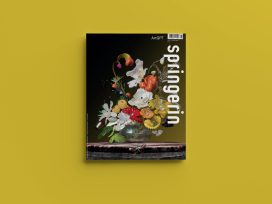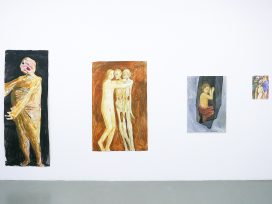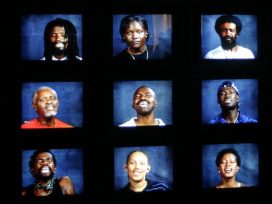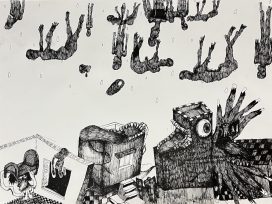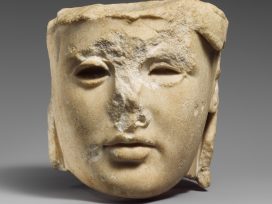The topography of the planet on which we live was shaped, and continues to be altered, by the movement of tectonic plates. The mountains, valleys and oceans are subject to titanic forces as those plates move and collide with each other. I became more aware of the scale of these forces than ever before when I flew from England to Seoul in November last year. The flight was routed to the north of the Himalayas and the aircraft was equipped with a downward facing camera connected to the in-flight entertainment screens of every seat. As the aircraft headed east from the darkness of Dubai and the world turned on its axis, it was possible to see the red and blue line of the dawn over India, and soon after to watch on the screen as the early morning light cast its shadows over the northern slopes of the greatest mountain chain on earth and over the vast flat plains to the north. The air beneath the aircraft was cloudless, and the land over 10,000 metres below was lit golden by the rising sun, casting blue shadows on the night side of the mountain peaks. It was an awe-inspiring sight.
My journey to South Korea was the last of the many journeys I made in 2007, in connection with my most recent book, Printmaking at the Edge. As a result of those journeys to a number of European, American, and Asian destinations, and in particular thanks to the insight gained from flying over the Himalayas, I have had the opportunity to consider some of the global shifts going on which are reshaping the world of the visual arts, and in particular the world of printmaking. The tectonic plates of that world are conceptual, not physical, and the changes coming about are not as a result of massive geological events. The collisions in the art world are between ideas and attitudes, in particular between the world of traditional printmaking and the media-enriched world of digital printmaking. However, these changes are bringing about a rapid evolution in printmaking, creating a situation that is very different from that with which I first became involved over two decades ago.
The position of printmaking within the contemporary visual arts has shifted a long way. In the early part of the twentieth century, printmaking was relegated to a place among what were termed “the applied arts”, a category including ceramics, craft-based woodwork, fabric arts, jewellery, and so on. That situation no longer applies. At the same time, the art of drawing has been repositioned, and is rarely seen these days as being subservient to painting, which was once the case. Indeed, in the case of both printmaking and drawing there has been a lusty assertion of their validity as autonomous disciplines that are not subservient to other visual art forms. The hegemony of painting and sculpture as the sole claimants to the term, “fine art”, is at last being broken, and I for one have no regrets at this change.
The argument that raged back and forth about whether or not digital printmaking could stand beside the traditional forms of intaglio and relief print can now be seen to have been just another step along the way from the argument some years ago regarding the validity of screen-print, and a similar argument about the place of photography in printmaking. Digital printmaking brings with it a different range of concerns, but I believe it true to say that, for most people at least, digital is now seen as just another technique for creating reproducible images. I doubt that Walther Benjamin, whose seminal essay on reproducibility in art continues to be influential, would argue with that assertion. Certainly in terms of the printmaking events and exhibitions I have been involved with over the past twelve months, there is now little tolerance of the self-imposed exclusivity that once haunted the world of print.
This is not to say, even for one moment, that the traditional forms of printmaking, such as etching, engraving, woodcut, mezzotint, collography, and silkscreen, together with combinations of these techniques, have lost their validity or their appeal to students and artists. The opposite seems to be true, with the expertise of the past being passed on, albeit in some cases through non-toxic variations such as Solar Plate, rather than the toxic processes that used to turn a printmaking workshop into something like an alchemist’s den. It is significant that many students and younger artists are exploring these well-established techniques and are finding new ways to use them in their search for self-expression. At the same time, there are some artists of the older generations who are turning to digital techniques with great enthusiasm, finding these technologically challenging methods suitable for their use. In between the two extremes of the generational range, there are artists who do not consider themselves to be printmakers in the traditional sense, but who have found that print techniques, singly, in combination with other techniques, or in hybrid forms, are ideal for their purposes, giving them new flexibility and new possibilities to extend the repertoire of their skills.
It is this complex and “all at once world” that has turned printmaking from being an often academic, and frequently very exclusive, form of the visual arts into something else entirely. The challenges and potential of the wide spectrum of available techniques have liberated printmaking from its former constraints and offer entirely new possibilities to artists from all disciplines. There are and will continue to be printmakers who would not wish to define themselves as anything else but this, and there will always be master printmakers who work with artists, whose main preoccupations are in other mediums, in order to realise their ambitions. The existing, more conventionally based, market for fine prints will for the time being ensure that these traditions continue. At the same time the growing community of artists, for whom the arts of printmaking offer opportunities that extend their practice and provide new means of expression, will continue to add new dimensions.
It is this plurality of approaches to the making of prints which form the tectonic plates of printmaking. The diversity of artists who are engaged in exploring the diversity of available processes, and the discussions, arguments and exchanges of ideas that flow freely around the world through conferences and over the Internet, are the sources of the energy for the vitality and continuing rapid evolution of the international printmaking scene.
Printmaking has to make its way through the minefield of the contemporary visual arts. That minefield is worthy of a much longer discourse than space allows in this article, but I will refer to three of the matters of concern to me that characterise what I see as being a malaise in the visual arts at this time.
The continuing commercialisation of works of trivial aesthetic value, together with the consequent lust for those elusive moments of celebrity that seem to have infected all areas of the media, have lowered the level of general public interest in the arts. Damien Hirst’s recent work, For the Love of God – a platinum skull studded with diamonds which allegedly was sold for �50million (around $100million US) – is one in a long line of barely interesting works that have, thanks to the efforts of Charles Saatchi and his cronies, turned Hirst into one of the richest people in Britain. Unsurprisingly, this object, and the expensive tee-shirts and posters that accompanied it, gained many column inches in the British popular newspapers, very little of which dealt with the aesthetic values, or the conceptual and technical details, but dealt instead with the claimed financial worth of the object, and the sense of outrage that this provoked. The conspiracy theories surrounding that skull are in themselves aspiring to the status of “art”, but as far as the general public is concerned, Hirst’s work is now a very expensive, tasteless joke. But, does this matter?
Then there is the case of the Turner Prize, initially set up to celebrate the great British artist J.M.W. Turner by rewarding an artist of promise. In 2007 the prize (a substantial one worth �40000/$80000 US) was awarded to Mark Wallinger for an installation that replicated the collection of boards, banners and artefacts of a man who set up a protest in Parliament Square, London, against Britain’s involvement in the conflict in Iraq. This installation had been dispersed by the time of the exhibition at which the prize was awarded, so instead Wallinger was represented by a video film of him walking around galleries dressed in a bear costume. Curiously enough, the popular press in Britain paid hardly any attention to this brainless stunt. It would not be inaccurate to say that the Turner Prize is now more or less discredited. Again, does this really matter?
A third example of the current state of the visual arts is the attention being paid by galleries across the world in the work of Chinese painters. A small part of the work being shown, and purchased at increasingly high prices, has a degree of aesthetic value which can be appreciated by more than a minority of people. The inherent quality of much else is dubious. However, the question has to be asked as to just how much of the attention and financial dealings involved is down to the machinations of a few gallery owners and dealers, and how much is down to real public interest. It is regrettable that the work of other Chinese artists who do not subscribe to the currently fashionable style of painting (and it is a dated and visually bankrupt style), but who work in sculpture, installation, and other forms, is not being equally celebrated or hyped. One is left with the inescapable conclusion that Chinese painting is the current “big thing”, which will one day be replaced by another “big thing”. It is the equivalent of the infection of the world with fast food and trendy fashion labels, and has little if anything to do with the real culture of contemporary China. Once again, does this really matter?
The views I have expressed are personal ones, but I believe them to be in tune with the attitudes of many other people who, like me, regret that the contemporary visual arts have to a great extent been hijacked by commercial and media interests. The former situation, in which artists produced work to the best of their abilities to share with the public, who were able to see the work in galleries (whether publicly of privately owned) and to buy it if they wished, no longer applies in the way it did. The days of the gentleman dealer are long gone. The prices for works of art continue to escalate, gallery owners and dealers strive to attain the status of celebrities, artists count their success in terms of the scale of their incomes, and all the major art museums count their success in terms of the gross takings of their souvenir and book shops and the gross numbers of people passing through their doors. The money men rub their hands in glee as the visual arts become just another commodity, traded internationally for cynical profit. It is little wonder that the majority of people in the general public no longer understand, or wish to be informed about, the visual arts.
I have drawn a bleak, and some would say excessively cynical, view of some aspects of the contemporary art world. If I felt that this view was the only one, I would probably give up writing about it. Thankfully, it is not the only view that I have of that world, and there is much going on to engage my interest and to provoke my continuing explorations and writings. Unsurprisingly, given the subject matter of my most recent book (Printmaking at the Edge, 2006) it is in the field of printmaking that I have sensed that much of the best work of artists can be found. What has also emerged significantly is that many of the best exponents of printmaking techniques are not primarily printmakers in the usually accepted sense of the word. Instead they are first and foremost artists, for whom the techniques of printmaking offer a particular attraction in the solution of problems. The distinction is not a simplistic one, nor is it an invention upon which to hang a particular writing agenda. It represents faithfully the facts of the present printmaking world, which has taken on a range of dynamics that would have astonished the printmakers of even two decades ago. For these reasons I also think that it might now be more appropriate to refer to “print art” and “print artists” and for the remainder of this article I will use those preferred terms, rather than “printmaking” and “printmakers”.
There is a particular feature of the world of print art in that it is an exceptionally transportable medium. Unlike paintings, which seem to be getting ever bigger and more suitable for large museums and galleries than for domestic surroundings, and which are costly to pack and transport, or like sculpture, for which the same comments apply, prints can be rolled into a cardboard tube and sent at low cost anywhere in the world. It might not be inaccurate to refer to some painters and sculptors as having megalomaniac tendencies, producing works on an enormous scale, not always for good reasons. Museum and gallery directors, as well as dealers and critics, collude in this continuing trend. By contrast, prints are generally created on a smaller scale than paintings and are therefore suitable for exhibition and display in a wider range of situations, in galleries as well as in domestic and commercial settings. In addition, their relatively low cost makes them accessible to a far wider buying public than most paintings or sculpture. They can also be transmitted with ease via the Internet, or captured on CD-Rom or DVD disks, enabling easy dissemination and study. It is for all these reasons that I have in the past referred to printmaking as being “the most democratic of the visual art forms”, being both accessible and affordable. I see no reason to change that view.
All of the positive factors of print art have been generally true until relatively recently, but I sense that there is an evolution in progress in which some artists are now beginning to create print art on an increasing scale, either as individual works or as installations. This in itself is not a bad development, but there might perhaps be a danger if print artists seek to replicate what has happened with painting, in which bigger is rarely better. During the Jury days for the 2006 Krakow International Print Triennale I observed that many of the rejected works, especially those in digital mediums, had a characteristic in common. This was that they were big, not for any discernible aesthetic reason, but simply because digital print machines and paper now allow for much larger prints. They were big simply for the sake of being big, and their size added nothing to their impact. If such a trend continues, there is a danger of alienating the loyal and enthusiastic following for print art that has built up in recent years, and the losses could perhaps outweigh the gains. These gains have been due to the proliferation of high quality exhibitions and competitions for print art, in particular through the regular triennials and biennial exhibitions and competitions. While the pattern of such events has shifted, with some events fading away and others coming to the fore – an evolutionary process that is a healthy development – the general standard of events and the quality of the works shown have risen steadily. At the same time, events such as the Krakow and Prague Triennials have become more welcoming to processes and techniques that are far from conventional.
The Krakow International Print Triennale is an interesting case in point. The 2006 competition and exhibition admitted multi-media works for the first time, as well as a larger number of three-dimensional works than in 2003. The inclusion of these unconventional works provoked quite a number of comments at the time, but they were generally well received by those who came to the exhibition. There were also many favourable comments from those who saw them at the subsequent exhibitions of works from the Krakow Triennale at the Horst-Janssen Museum in Oldenburg and at the K�nstlerhaus in Vienna. The connections in these works with traditional print, and with conventional definitions of what could be included in such exhibitions, were at the very least tenuous. However, their presence gave a fresh and interesting ingredient to an event that could, had such works not been included, have started to become stale. The jury decided to mark the widening of the Triennale by awarding an Honourable Mention to Ksawery Kaliski for his interactive computer work, Przeciw Nicosci – Calosc i Nieskonczonosc (Against Nothingness – Entirety and Infinity) which allowed visitors to the exhibition to manipulate the sequence of projected graphic images by inserting their hands into interactive rings, thereby determining an individual presentation of the images in the computer program.
The Prague Triennale is distinct from the other major exhibitions and competitions in that all the artists whose work is shown have already been the recipients of awards at other events. The prizes awarded are therefore given to what in Britain is referred to as “the cream of the cream”, and give a partisan but generally reliable indication of trends in the print arts. In the 2007 Prague Triennale, the Grand Prix was awarded to Egle Kuckaite, a Lithuanian artist who had previously won the Grand Prix at the 2004 Tallinn Triennale. The international jury, comprising academics, artists, and critics, was unanimous in its opinion that this work was worthy of the highest award. Her work, Switching to the Light Mode, is only tangentially connected with the conventional notion of printmaking in that she uses rubber stamps of different sizes bearing images derived from her drawings to create a large scale image directly on the wall of a gallery. There is no possibility of permanence or of reproducibility – the installed work exists for a limited time, to be recorded only in photographic images and memories. Kuckaite’s work in Prague showed a dialogue between Chiurlionis and Kafka, sitting opposite each other and winding wool – an essentially domestic activity that requires both concentration and cooperation. She says of this work, “…a distance – a respectful distance – is required for this act. In the symbolic language of the twining of threads I am talking about the individuality of the personalities mentioned, the exclusivity of the act”. This work created a profound and powerful link between two creative giants, each of whom has become emblematic of the culture of their very different European homelands, but each having a wider international relevance as well. Seen in this context, Kuckaite’s work created eloquent links between the worlds of contemporary print art and of contemporary visual art in general, and between different aspects of European culture.
This brief summary of two examples of the way in which highly regarded international events are changing is only part of the story. Print artists have one great advantage over artists in other mediums, with the possible exception of video artists, in that their work is very transportable and transmissible. In addition, print artists are part of what is becoming a strengthening phenomenon – the global print community. Over the past ten years or more, there have been increasing opportunities for those who make, write about, or are simply interested in print art to get together at conferences and meetings in different international locations to present ideas and take part in discussions and workshops.
The Southern Graphics Council that originated in the south-east of the United States in 1972 organises an annual conference that has grown in scale and ambition. In March 2007 the conference was staged in Kansas City and attracted around 1200 delegates from some 20 countries, a scale very different from the early conferences. This conference has become an important and influential meeting at which theories and practices can be discussed and demonstrated. In addition, a wide variety of exhibitions and workshop visits is arranged, widening still further the excellent opportunities that are provided to explore and assess the current condition of print art. Naturally, in addition to the formal sessions, much of the communication between delegates happens during the more relaxed social meetings in bars and restaurants. The international dimension is welcomed by the organisers as it provides a strong fertilising element introducing new ideas and fresh approaches that feed into the American educational and gallery systems.
The biennial Impact conferences, which in 2007 celebrated the tenth anniversary of the event’s foundation, are even more international in reach and ambition. The first conference was organised in Bristol, UK, to be followed by conferences in Helsinki, Capetown, Berlin/Poznan (a highly successful dual venue event that included moving all the delegates each way between the two cities by train), and in 2007 in Tallinn. The conference was based in the extraordinary Kumu Art Museum and in the nearby Kadriorg Palace, as well as encompassing a wide number of exhibitions and events throughout the city. To have the opportunity to experience a truly international event in a wonderful variety of locations in such an historic city gave those who attended the Impact 5 conference an exceptional opportunity to meet other practitioners and to discuss a wide range of practical and theoretical topics. It is unlikely that anyone attending the conference would have returned home without having gained great encouragement of their faith in, and commitment to, the making and sharing of print art.
The downside to such conferences is that they now contain so many sessions and workshops that it is impossible for any delegate to attend everything that they wish, inevitably leading to having to choose between events happening at a particular time, and to missing out on something of interest. There is no immediate answer to such a dilemma as organisers understandably want their conferences to be as distinctive and inclusive as possible. Bigger is not always better, and more can sometimes be gained from participating in a smaller event, such as the Symposium in September 2007 that accompanied the K�nstlerhaus, Vienna, an exhibition of work from the Krakow Triennale. Despite this small criticism of such major conferences they still remain one of the great strengths of the contemporary visual arts world, demonstrating without question that print artists have the confidence to share their ideas, skills and ambitions. There is no doubt that such a sharing has a continuous fertilising effect on print art, and that the participants derive great benefit from meeting with people from around the world. The consequent spin-offs of academic and workshop exchanges, and of exhibition, publication and portfolio opportunities, continue to provide a central strength and common purpose in contemporary print art.
If, as I believe, the making of art is an extension of the human spirit, and that we benefit more from talking to each other rather than about each other, then print art and those who practise it have much to offer to the world. While print art is becoming more widely recognized it remains a concern that many major museums and galleries still do not seem to be willing or able to recognize the contribution that it can make. Perhaps it is true, as the Austrian artist Michael Schneider observed at the Kansas City conference, that mainstream dealers still do not trust “printmaking” because they know it is revolutionary and therefore untrustworthy. Anarchy doesn’t make money – but then it should never intend to, or it ceases to be anarchy. While print artists might be somewhat envious of those artists who make more money by working in other mediums I think they will also recognize that the making of editions or individual works that sell at relatively lower prices gives them a freedom that is lost by those artists who wed themselves to the insatiable demands of the international fine art money machine.
After the opening of the 2006 Krakow Triennale exhibition, I was talking with Professor Witold Skulicz who has been a powerful guiding force to the Krakow event for many years. He told me that he was considering the possibility that the word “print” might perhaps be omitted from the event title in 2009, so that it would become the Krakow International Triennale. This idea is a revolutionary one, and might not be well received by the more traditional members of the arts community, but it would signal an important change of direction. It would also place print art firmly within the generality of the contemporary visual arts. No doubt the idea will be much discussed in the coming months. Regardless of whether or not this name change occurs, it is certain that print art is in a strong position and has the potential to develop still further as a major contributor to the contemporary scene. Now that the arguments of the past that risked splitting the former printmaking world seem to have been resolved, the future development of print art and the artists who pursue it might well prove to be one of the most exciting and challenging art forms in the next decade. At the very least, the tectonic plates of print art will continue to shift, producing unexpected and unpredictable possibilities which artists in tune with those shifts will continue to exploit. With strong traditions and an honourable record of past achievement, what happens next will be fascinating to observe.
Wales, January 2008
